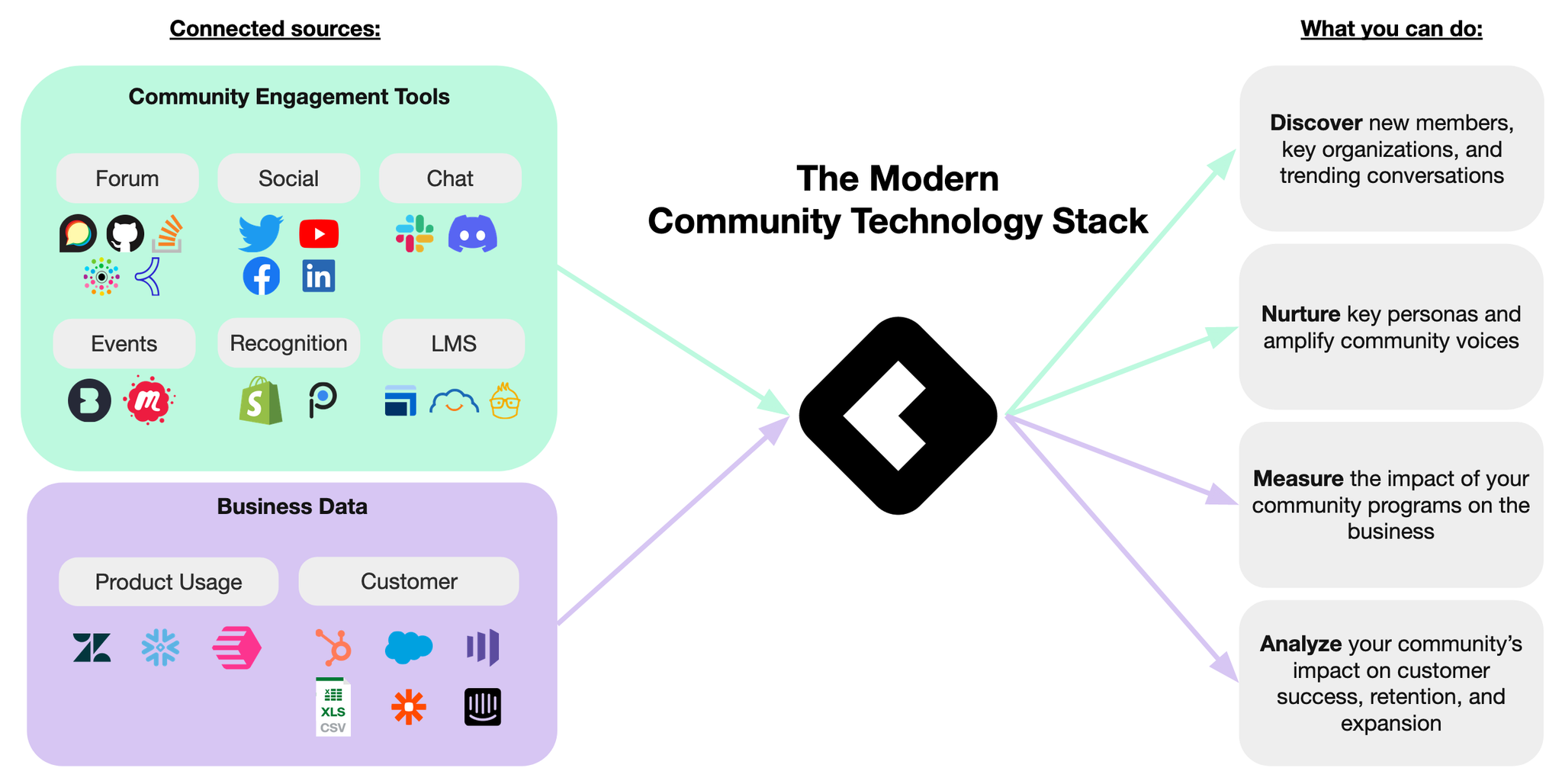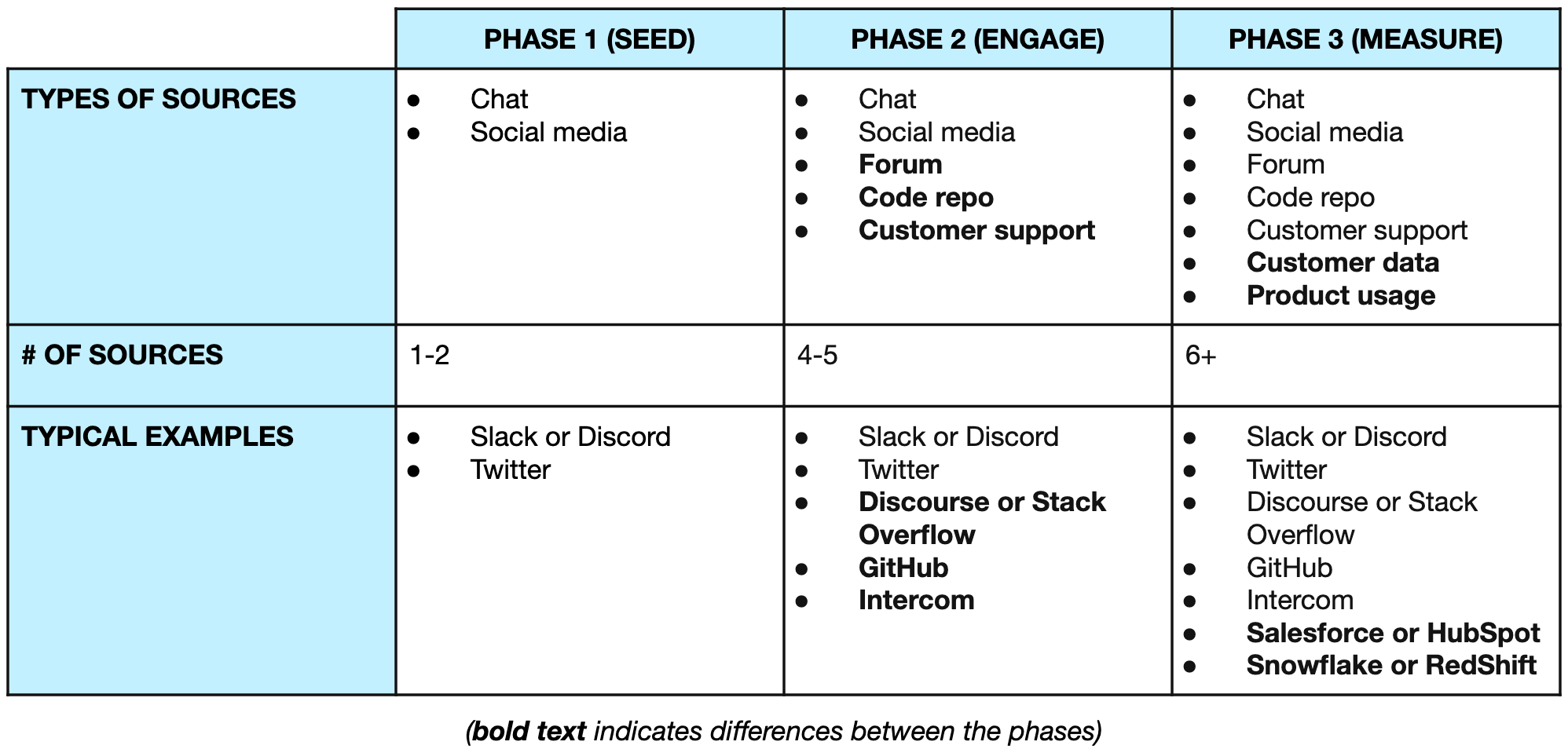At Common Room we’re serving over 2 million community members and have unique insight into how organizations successfully build communities, including what makes an effective community technology stack. Our customers follow a community maturity curve across 3 phases: seeding the community (phase 1), facilitating growth and sustained engagement (phase 2), and showing community impact on the business (phase 3). To mature from one phase to the next requires the adoption of multiple platforms and an integration of community and business tools and internal company data.
As a community manager, you play a critical role in advocating for investment in additional platforms and tools to not only do great community engagement work, but to also bring your whole organization closer to your community and drive business impact. These dual goals are likely reflected in conversations you have with leaders and counterparts in marketing, customer success, and community operations when trying to answer questions such as “How do I better prove the value of our community work to our business objectives?” and “What combination of tools are others using to achieve this?”
We’ve previously covered the technical considerations you should work through when building your community technology stack. In this article, we’re going to share a roadmap for how to start measuring community impact against business objectives. We'll highlight the additional tools and data sources you should include in your community technology stack—and connect to your community intelligence platform—to both support your community through its stages of growth and demonstrate its positive impact on your business.
Overview of data providers
There is no shortage of tools for a community manager to choose from, and the list continues to grow every day—Lisa Xu recently drew this community solutions landscape visual. To help make better sense of what’s out there, we think about tools across two broad buckets: community engagement and business data.
Community engagement tools are designed to encourage and facilitate interactions between community members themselves and also between members and your company. They are focused on many different categories, including chat, forum, social, developer-specific, customer service, events, recognition, and learning management systems, to name a few. To meet the varying needs of different communities, the engagement these tools provide can take many forms, such as conversations, pull requests, identification of bugs, product feature requests, event attendance, public speaking engagements, and the passing of certification exams or other badges of expertise. In other words, these are various ways in which community members can build up their social capital.
As it relates to business data, there are tools storing data about your customers, product usage, and revenue. Typically this is internal or proprietary company data that adds business-specific context to your community engagement data, such as what pricing plan they’re on, what parts of your product they use most (or least) often, and how much they’re spending with you. This type of data is commonly stored in a data warehouse and / or a CRM.

For the full list of source integrations supported by Common Room, click here.
Community technology stack by maturity curve
The tools in your community technology stack enable you to build and engage your community through each phase of the community maturity curve. The seed and growth phases typically involve what we call “community integrations,” many of which are free to get started on (for example, Slack has a free tier, Discourse is open source, and services like Twitter and GitHub are free to use). As you graduate to measuring business impact, you’ll start connecting “business integrations,” which are typically paid tools like Salesforce and Snowflake. Investing in the right mix of tools will help you support your community and achieve your business goals, which should reflect your community’s goals—a better experience delivered faster—in each phase. Below is a table summarizing a representative stack by phase:

Phase 1: Seeding your community
In the first phase, you’re focused on building a vibrant community, typically with a chat and/or social media platform like Slack, Discord, or Twitter. You want a space to provide product support, offer hands-on demo opportunities, and facilitate connections between community members. Your efforts will be on trying to increase membership and the number of interactions or engagements within your community. If you start seeing community responsiveness—community questions being answered by other community members—increasing, that’s a sign that you’re building a self-sustaining and healthy space.
Phase 2: Facilitating growth and sustained engagement
As your community continues to grow, you’re looking to support and manage more ways for members to interact with your company, your product, and each other. At this phase, we typically see customers adding a forum (like Discourse or Stack Overflow) to offer a searchable knowledge base, a code repository (like GitHub) for pull and feature requests and feedback, and/or a customer support platform (like Intercom) to manage support tickets. Investing in these additional sources of engagement and communication allows you to identify key contributors, champions, and advocates—members with top activity across multiple sources—to amplify their work and elevate their expertise. You can partner together with your most active and knowledgeable community members to do things like launch workshops and training programs that educate the next generation of product champions, co-create blogs and tutorials, and speak at events. Putting it all together, with a growing and more engaged community, you can begin to analyze the reach and effectiveness of product education, and understand if increased peer-to-peer knowledge sharing correlates to a reduction in required internal support resources (like fewer tickets or shorter resolution times).
Phase 3: Showing community impact on the business
In this phase, you’re ready to measure and report on direct attribution of community activity against your company’s business goals (typically product adoption and revenue). This means being able to answer questions like, “Does your product get stickier or grow adoption within an organization as members spend time in the community?”, “Does community engagement assist with closing customers faster?” and “What is the impact of community engagement on the overall customer funnel?”
This is where we see our more sophisticated community-led customers connect their business tools and internal company data into their community technology stack. This is usually customer data—such as Salesforce or HubSpot—and product usage—stored in a data warehouse like Snowflake or Redshift. Now you’re able to create an end-to-end link from when, how, and why a member joined your community, what their activity is like, and their progression through your sales process to becoming a paying customer. In other words, you’ll be able to qualify leads as originating from the community and track their journey from when they start using your product through to how much revenue is attributable to them.
From a product adoption perspective, you can start comparing the health of accounts with community members vs. those without, and its impact on expansion and retention. You can identify which users are highly active in the product but aren’t participating in the community, and dig into why that is. You can also identify members who are inactive in both the product and in the community, and try to provide more individualized outreach to these at-risk members. All of these engagement trends can be broken down even further by region, plan or role type, and any other customer or product-specific filters that are tracked in your business tools.
From a revenue perspective, now you can analyze the relationship between community activity and revenue at a more granular level. For example, you can calculate what percent of your revenue is from users from the community and use this metric as a measure of how impactful your community program is. You can also start to identify key behavioral characteristics common across high revenue customers - such as how many community platforms they participate in, what kind of posts they share, and how frequently they engage - to understand where you might be able to improve your community programs and better meet the needs of your members and customers.
Now that we’ve covered the tools you should have in your community technology stack as your community grows—and thrives—across the community maturity curve, it’s time to talk about how to get a holistic view of all the data these tools provide.
A single source of truth for community, customer, and product data
Integrating information across your tools and systems is critical in scaling your community efforts, regardless of the maturity phase your community is in. Without it, your impact is limited by the manual time you have to spend tying data together without adequate visibility into the true impact of your programs. We built Common Room to solve this.
Common Room is the industry-leading intelligent community growth platform. We allow you to instantly connect your community engagement across all channels—including product usage and revenue data—to unlock intelligent insights that let you take action to grow happier customers, measure outcomes, and drive business impact. Ultimately, we want you to build better products, deepen relationships, and grow faster, and your ability to do that accelerates when you can advocate for enduring and deep community investment. For more, read how our customers like Asana, dbt Labs, Moov, and Temporal are using Common Room to build stronger communities and drive business impact.
Try out Common Room for free.
